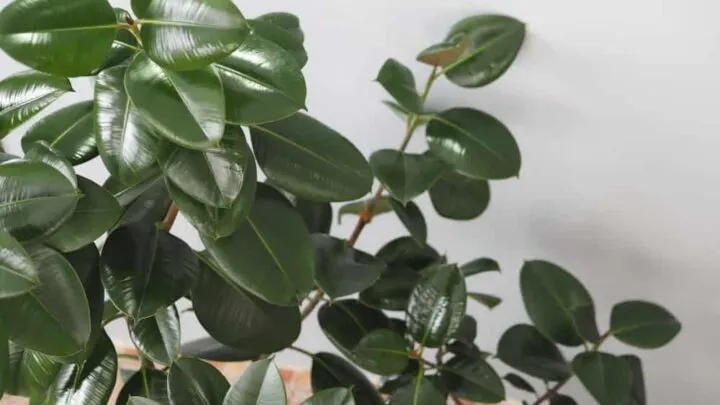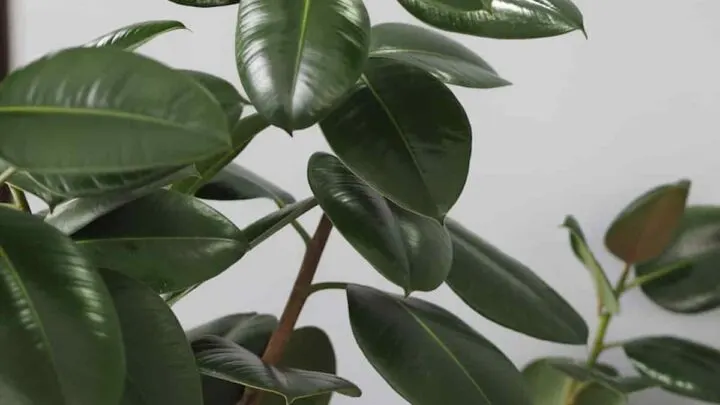Rubber plants are an exceptional indoor plant to grow with large, shiny, and leathery leaves that will brighten and add life to any room. Originating from Southeast Asia, where they are known as rubber trees, this species can grow up to 100 feet tall in their native environment. Rubber plants cultivated indoors can grow to be anywhere from 4 to 10 feet tall, depending on available space and growing conditions. Rubber plants are a fairly hardy, indoor ficus plant with minimal care challenges; however, when issues arise, what houseplant lovers may be wondering is why is my rubber plant drooping?
Rubber plants tend to droop when they are improperly watered. This includes over or under watering. In addition, lack of sunlight or nutrients, or being rootbound can cause them to droop.
Read on to learn more about best care practices for rubber plants.

Causes & Solutions For A Rubber Plant Drooping
Despite the resiliency of the rubber plant, inappropriate or inconsistent distribution of water, light, or nutrients could all contribute to the drooping of the plant’s leaves or branches. Over or under-watering are the most common causes of rubber plant droop, but it’s important not to rule out the other possibilities shared in this section of the article.
Overwatering
Overwatering is the most likely possibility as to why one’s rubber plant may be drooping. If overwatering occurs, soil can become so full of water that it is unable to distribute nutrients to the roots of the plant. Rubber plants thrive when soil is allowed to fully dry out between watering.
In addition, it’s beneficial not to allow water to touch the leaves when watering as this can cause staining of the luscious foliage for which rubber plants are known.
Overwatering of a rubber plant can be identified by soft, mushy, yellow, or browning leaves and waterlogged or smelly soil. In extreme conditions, root rot and pest issues may also arise.
If overwatering of a rubber plant is known or suspected, it’s important to take action immediately, do not wait for the plant to dry out organically. Root rot may have occurred, so removing the plant from its current pot and cutting off any damaged roots will aid in recovery.
Then, repotting the plant into a new container with dry soil and appropriate drainage is necessary. Also, remove any mushy leaves so the plant can efficiently distribute energy towards new, healthy growth.
Underwatering
Although it is crucial not to overwater a rubber plant and allow it to dry out between waterings, regular underwatering of the plant can still create life-threatening conditions. Typically rubber plants need to be watered weekly during periods of growth in summer and twice a month when they are more dormant in winter.
If the plant is drooping and leaves are dry or crispy, underwatering is most likely the cause. Extensive underwatering may also cause the plant’s leaves to start to brown. If soil is so dry that it is creating a dusty effect when touched, this is more insurance than underwatering has become an issue.

Although one’s first instinct may be to douse a dehydrated rubber plant with water, this can cause the plant to drown or go into shock. Instead, the best solution is to gradually rehydrate the plant, watering in small quantities two or three times a day for a week or two.
This results in slowly adding moisture to the soil versus shoving water through dry soil directly to the roots and shocking the plant. Moving forward, learning the humidity and natural moisture of one’s growing environment and watering accordingly can result in consistently hydrated soil that is also not overwatered.
Fluctuating Light Or Temperature
Rubber plants prefer a plethora of bright but indirect sunlight. Drooping of a rubber plant could mean receiving too much or too little regular light or being exposed to temperatures that are too cool or warm.
Remember that rubber plants derive from rubber trees that grow naturally to be quite large in tropical Southeast Asian environments. They will grow most successfully in environments that stay within a range of 55 – 85 degrees Fahrenheit.
If a rubber plant has been exposed to less than ideal light or temperatures, the best solution is to move the plant or alter its existing environment. If the light is an issue, relocating the plant further from the window or adding a translucent curtain can help mitigate too much light’s negative effects.
If the temperature is the cause, then adding a fan to an environment with too much heat or a heater to an environment that is too cool can support the plant in transitioning back to positive health.

Rootbound
While it is less common for a rubber plant’s droopy leaves to be caused by constriction of the roots, it is not impossible. Especially when a rubber plant is given appropriate moisture with ample light and appropriate temperature, rootbound effects may occur.
Although some gardeners of rubber plants may choose to keep their plants small, sometimes the plant may disagree, resulting in plant droop. If rootbound is the cause of your rubber plant drooping, additional signs may include that the size of new leaf growth is small, as well as easy wilting and leaf fall off. In extreme conditions, you may see roots protruding from the pot.
The simplest, and in many cases the only, solution to fixing a rootbound rubber plant is to repot it into a larger container. If repotting a rubber plant is necessary, moving it to a container with 2 – 4 additional inches in diameter and depth is preferable.
Additionally, provide as much fresh soil as possible to help neutralize any pre-existing issues with moisture or nutrients in the soil.
Lack Of Nutrients
Rubber plants are hardy enough that typically providing them with the appropriate amount of light, hydration, and space will result in optimum plant health.
However, if a rubber plant lacks nutrients, it may droop, show signs of weakened stems and leaves, or appear paler in color. Soil nutrients can be assessed through soil test kits that can be purchased online and at most garden centers. It’s essential to use these kits to identify soil needs before adding nutrients.
If a rubber plant is drooping due to a lack of nutrients, it is most beneficial to add an NPK fertilizer to help revitalize it. NPK = Nitrogen (N), Phosphorous (P) and Potassium (K).
These fertilizers come in various ratios; however, the ratios most ideal for rubber plants are equivalents such as 5-5-5 or 10-10-10, meaning there are equal parts of each component. To avoid nutrient issues and support the health of rubber plants, it can be useful to provide the plant with an NPK ratio of 10-10-10 about every three months.
Final Tips For Growing Rubber Plants
Meeting the needs of a rubber plant’s hydration, light, soil, and nutrients will most likely ensure success in growing this lovely plant indoors. However, it is crucial to mention that rubber plants can be toxic to humans and animals and may be dangerous in home environments, including for pets or young children.
The responsibility of indoor plant enthusiasts is to consider these factors before growing rubber plants in one’s home. At times, an out-of-reach location can be successful in ensuring the safety of at-risk family members. If there is any uncertainty, choosing an indoor plant variety that can not negatively affect the health of loved ones is recommended.

Hi there, my name is Allie and welcome to my blog; GareningWithAllie!
Much of what you see written here is just our personal experiences with gardening. Along with the content I write here, there is also a unique collection of gardening topics covered by some of our close friends. I hope you find everything you read here to be helpful, informative, and something that can make your gardening journey the most lovely experience ever! With that said, Happy Gardening!
